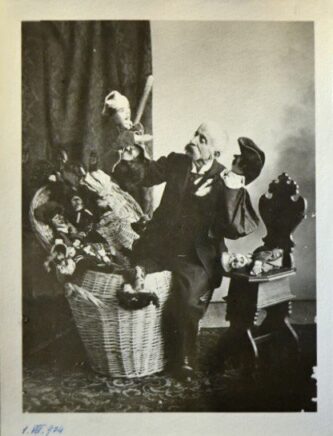Angelo Cuccoli
The son of Maria Gasperini and of the famous puppeteer Filippo Cuccoli, Angelo Cuccoli was born in Bologna on October 12, 1834. He was not very talented in his father’s profession at first (because of his timid and uncertain voice); he started with other jobs before joining his puppet theatre in 1857. Because he could not compete with Filippo’s rendering of the character of Sandrone, Angelo Cuccoli chose that of Fagiolino, turning it into one of Bologna’s favourite characters.
After the death of his father, Angelo Cuccoli rebuilt his repertoire around the character of Fagiolino and drew inspiration from mixed theatrical material. “Essentially, he did not create anything, but he adapted to the habits, customs and desires of the Bolognese people all the most vivid and original legends and stories that have been honoured on stage in the old Italian and French theatre” (Albano Sorbelli, “Angelo Cuccoli e le sue commedie”, in L’Archiginnasio, IV, 6, 1909). Several Bolognese puppeteers from the following generation were trained in his hand-puppet theatre; the first was Augusto Galli who worked with Cuccoli for more than ten years, but there were also Gaetano Chinelato, Guiseppe Mazzoni and Ciro Bertoni. In 1877, the municipality moved the Cuccolis’ hand-puppet booth from the arcades of the Podestà (where it had always been) to the Piazza S. Francesco, more peripheral; this marked the decline of the theatre. In 1904, Angelo Cuccoli started a dialectal theatre troupe, the Compagnia Felsinea, in the Nosadella theatre. He passed away shortly after in Bologna, on February 9, 1905.
Most of Cuccoli’s outlines were bought by the municipality of Bologna in 1935: this includes several complete comedies and about three hundred outlines. Some were published in Albano Sorbelli’s work mentioned earlier.

Angelo Cuccoli with his large ‘basket’ of glove-puppets